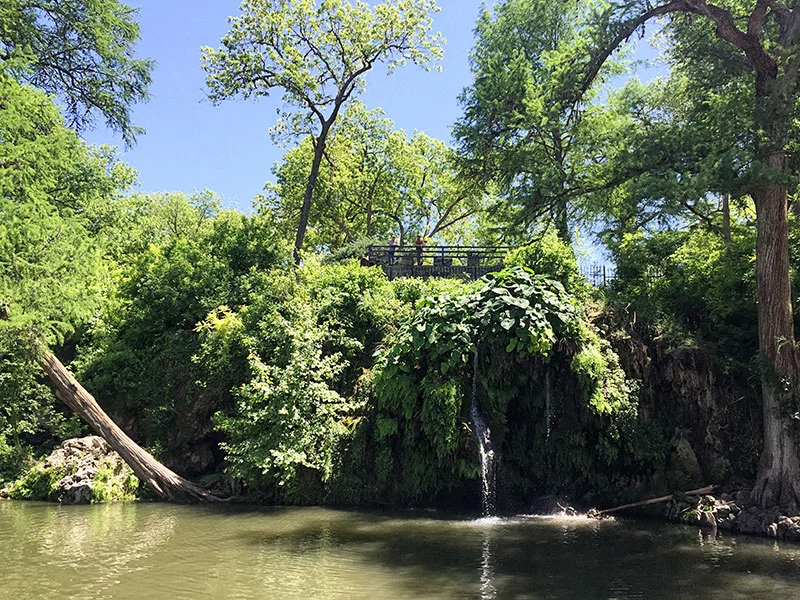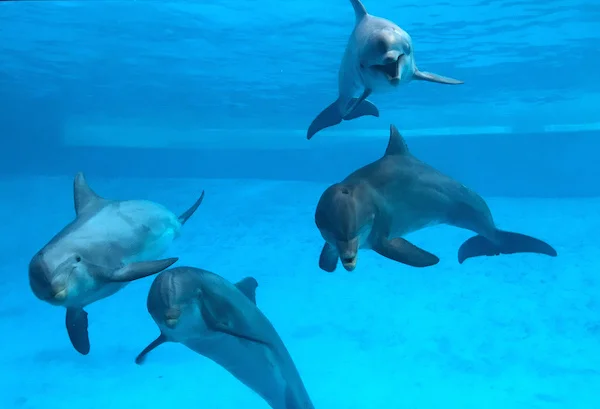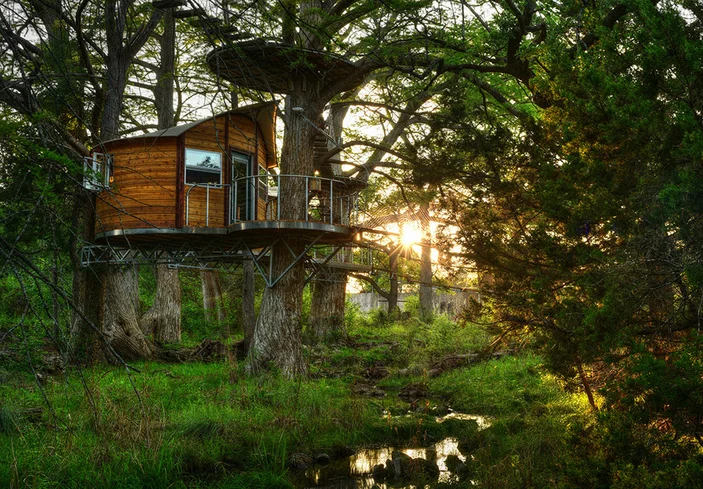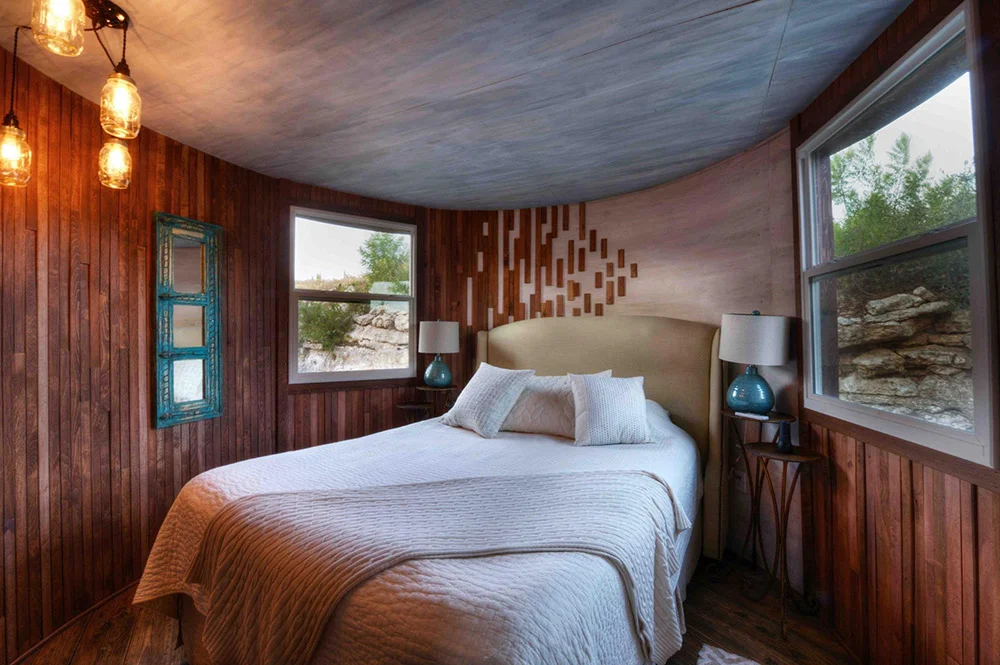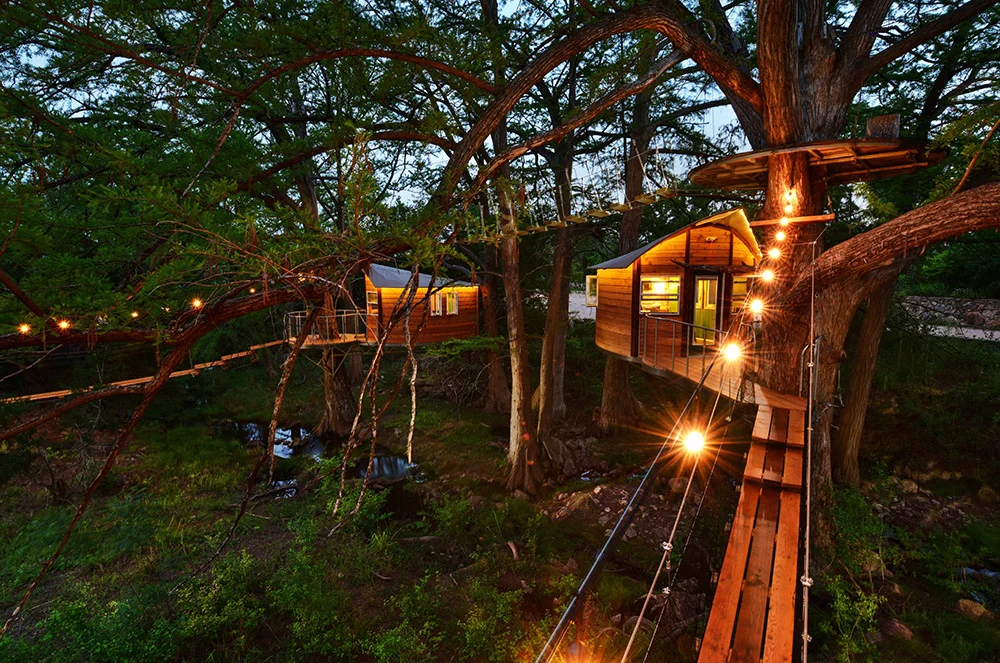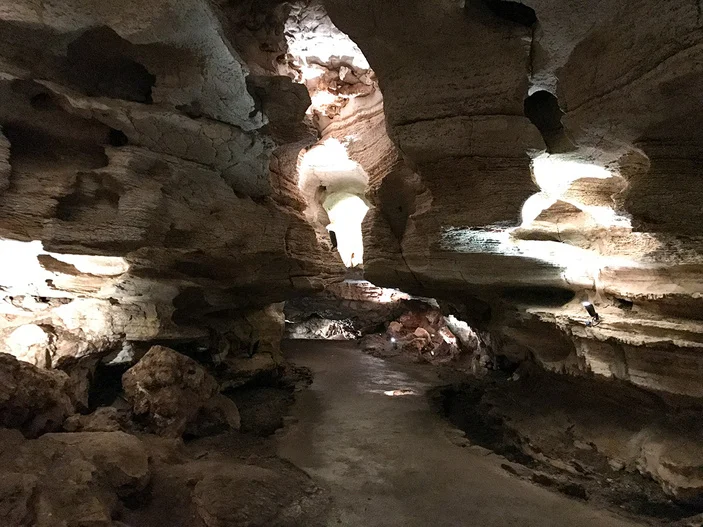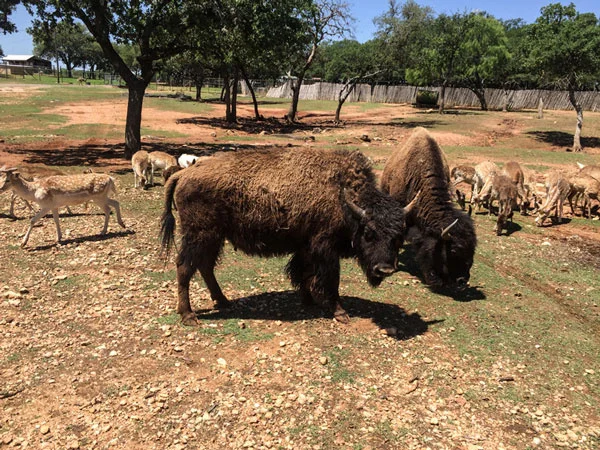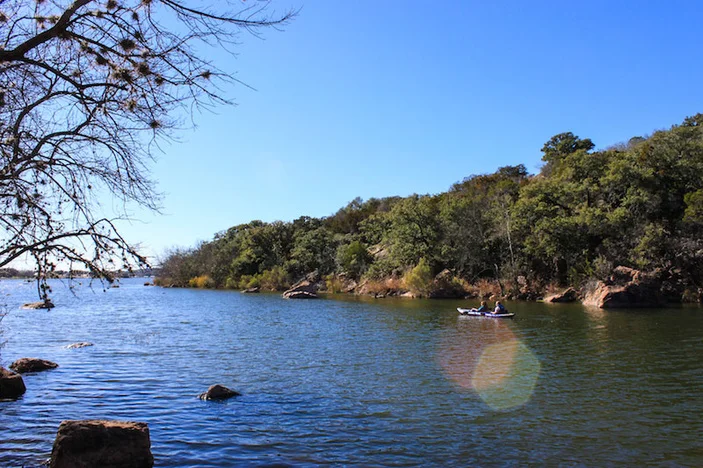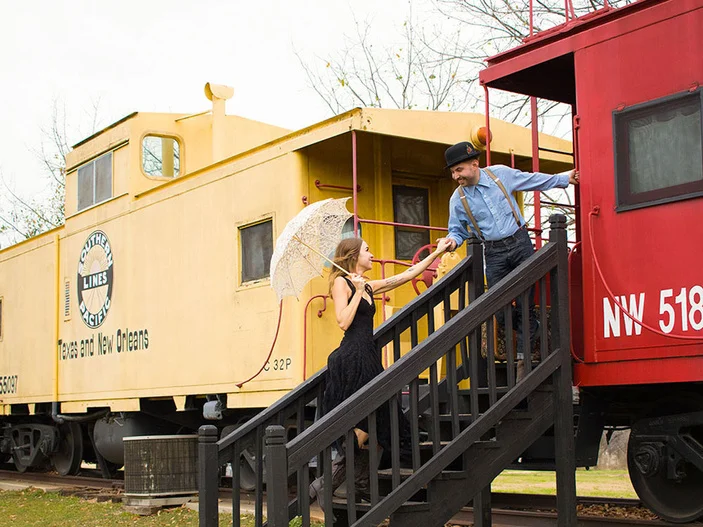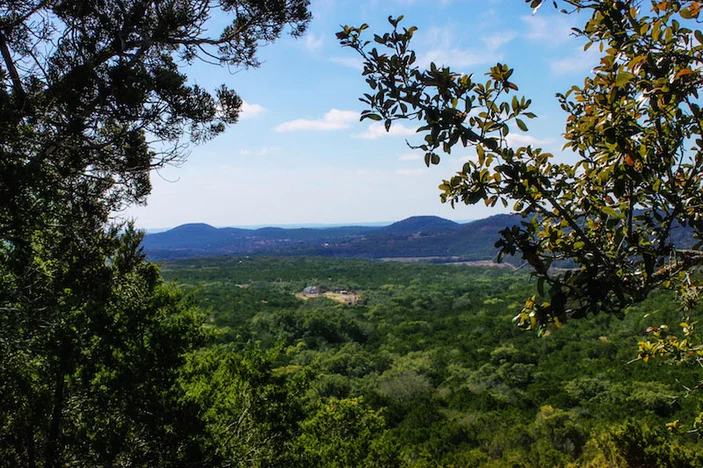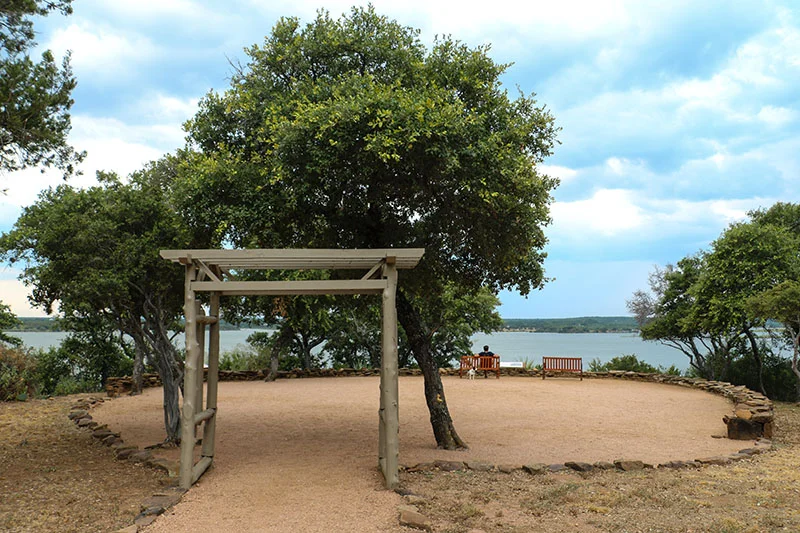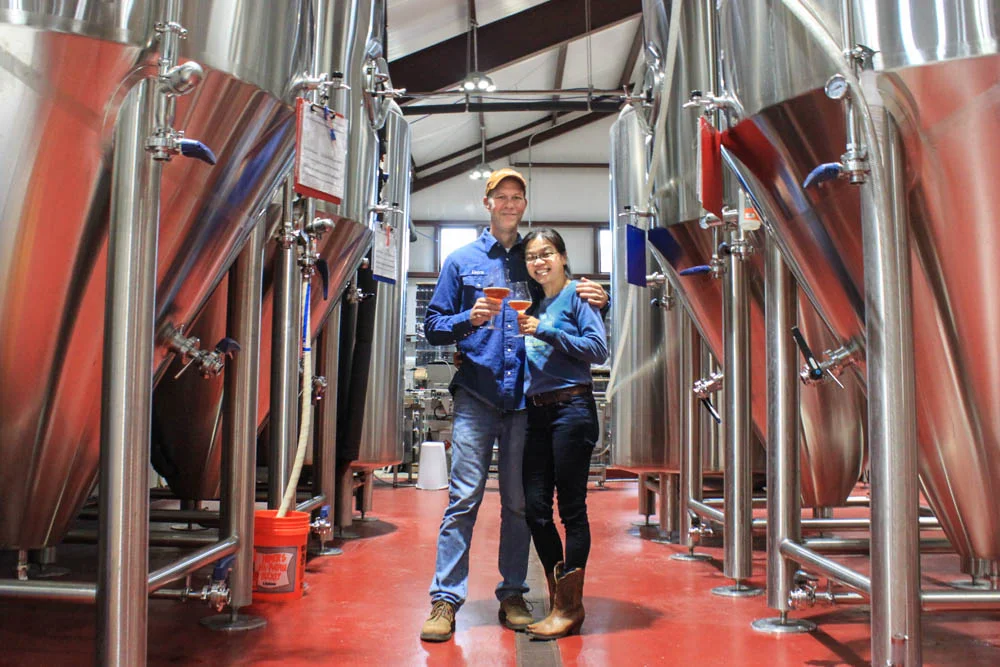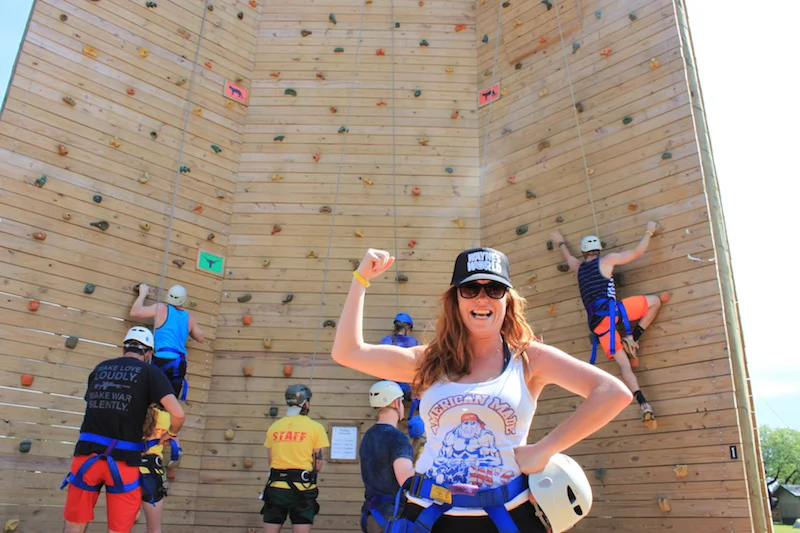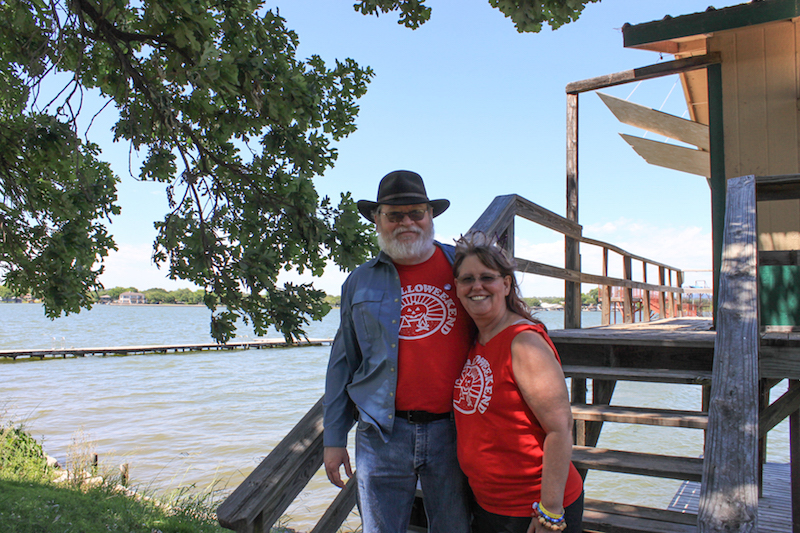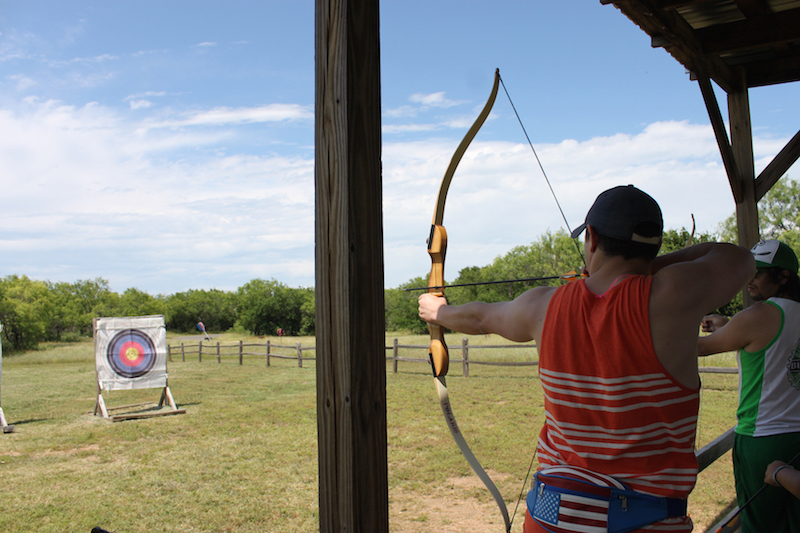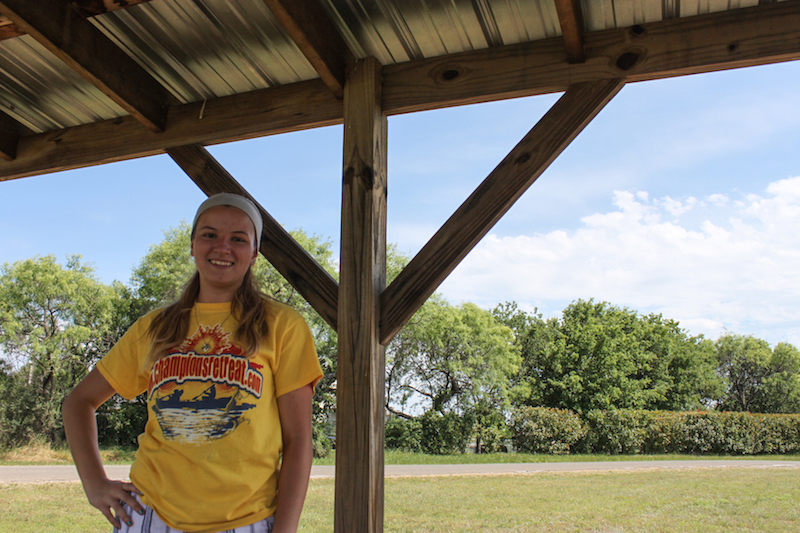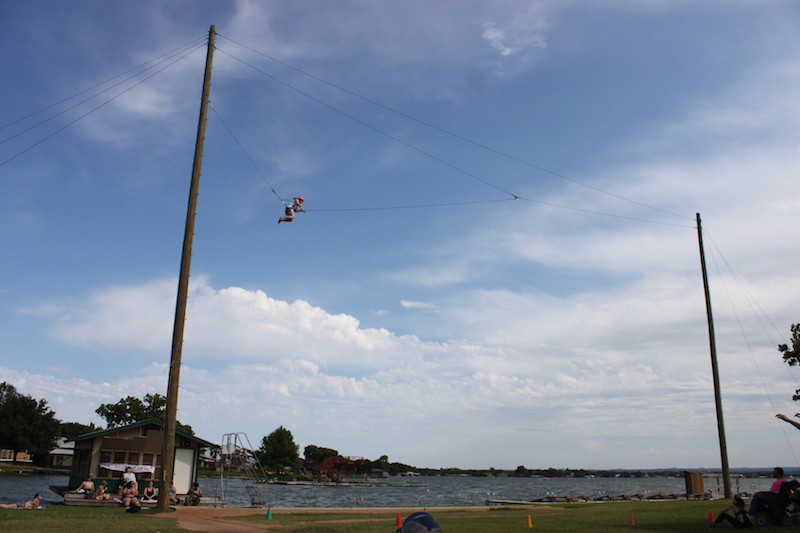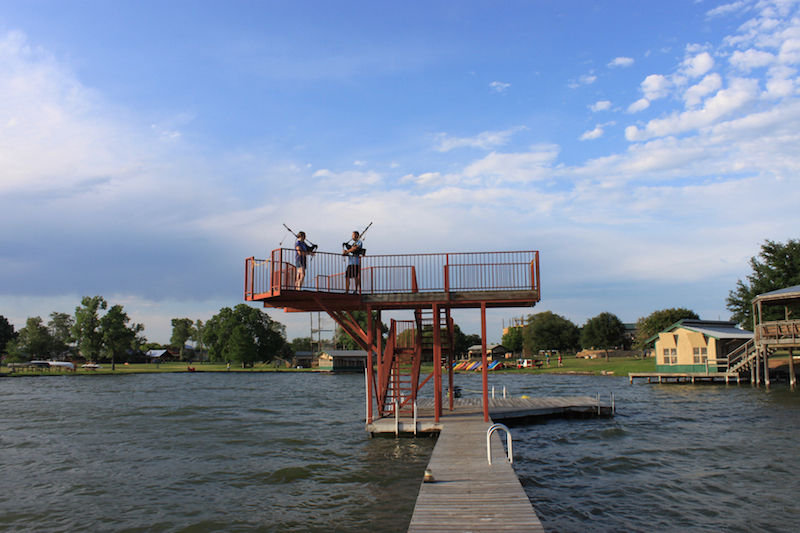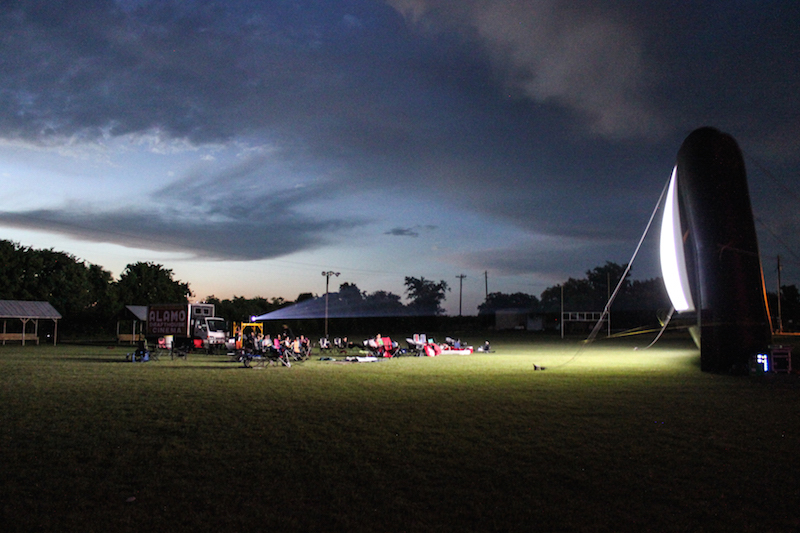Krause Springs a Swimming Hole Eden in Spicewood
Published at 101HighlandLakes.com
People have enjoyed cooling off in the spring-fed waters of Krause Springs in Spicewood since 1955. Photo by JoAnna Kopp
The setting is Krause Springs, a beautiful natural swimming hole located in Spicewood.
Picture sitting in the shade of ages-old oak and cypress trees creating a canopy overhead. You look straight out to a waterfall trickling down into a deep pool of fresh spring water.
The Krause Springs swimming remains a crisp 68 degrees year-round, so it’s a haven for locals looking to beat the heat this summer.
Privately owned by the Krause family (pronounced Krow-see with a short “o” sound like in “cow” — take a look at our local pronunciation guide for more), Krause Springs has been enjoyed by visitors since 1955. Krause Springs is well-developed and maintained with pavilions, stone barbecue pits, picnic tables, restrooms, showers and more. There’s even a butterfly garden with hammocks and wind chimes for visitors to enjoy.
Kick back and relax in the Butterfly Garden at Krause Springs. Photo by JoAnna Kopp
The property sprawls across 155 acres with 32 springs that feed the natural swimming hole and the manmade pool. The springs are always flowing, so the pools remain at a constant level.
When you first enter Krause Springs, you’ll come up on the manmade pool, which is on a cliff overlooking the much larger natural swimming hole. The spring-fed pool is very nice and quite deep. It flows into the lower pool, creating the picturesque waterfall.
The manmade pool in Krause Springs is shaded by ages-old trees and fed by natural spring water. Photo by JoAnna Kopp
Take the steep staircase down to the lower pool. There’s a large rock slab for a picnic or sunbathing. Be extremely careful when traversing across it — it is very slick. There is a cave underneath the waterfall that you can swim in and explore (at your own risk; who knows what lives in there?) And don’t forget the rope swing, which is great fun for thrill-seekers.
There are many camping spots across the property, including 24 RV hook-ups. Primitive camping is first-come, first-served, but you can reserve a spot in advance for RV hook-ups.
Take a dip in the water that stays at a crisp 68 degrees year-round. Photo by JoAnna Kopp
The gates at Krause Springs are open daily from 9 a.m. to 9 p.m. The property welcomes the public 10 months out of the year. (The family takes a short break in the winter.) Krause Springs never closes after rain and flooding, so you will not be turned away.
Bring cash! Credit cards are not accepted. Admission is $7 per adult, $5 for children ages 4-11 and free for children under 4.
Krause Springs is located at 404 Krause Spring Road in Spicewood, Texas. For more information, visit krausesprings.net or call the office at (830) 693-4181.
Behind the scenes with the dolphins at the Texas State Aquarium
Published at 101CorpusChristi.com
The Texas State Aquarium hosts four male dolphins: Liko, Schooner, Kai and Shadow. Photo courtesy of the Texas State Aquarium
Dolphins are like children. Big, slippery children. They are playful, curious and immensely lovable. Also like children, taking care of them is a huge responsibility. The Texas State Aquarium is home to four: Liko, Schooner, Kai and Shadow.
I went behind the scenes to meet the dolphins and their two trainers, Emma Gilbert and Sarah “Ziggy” Zigmond. A day in the life of a dolphin trainer is exciting, rewarding and long. The trainers are with the dolphins at least 12 hours a day. They are on call 24 hours, ready to respond to any emergency.
Trainer Sarah ‘Ziggy' Zigmond leads the dolphins through their routine at the Dolphin Bay exhibit. Photo courtesy of the Texas State Aquarium
“We are here all the time,” said Gilbert, curator of marine mammals. “The dolphins never go longer than 13 hours without us. I’m so busy, but it’s so amazing.”
The Texas State Aquarium is accredited by the Association of Zoos and Aquariums (AZA). This means the aquarium abides by the highest possible regulations for animal management and care. The AZA keeps strict standards for facilities and daily routines. The aquarium strives to go above and beyond the base guidelines. For example, the Dolphin Bay exhibit holds 45,000 square feet of water, nearly double the AZA’s space requirement.
A WHOLE LOT OF FOOD
Everything behind the scenes is scrupulously clean. Anything that goes into the water with the dolphins, such as toys or wetsuits, follows a strict disinfection protocol. The kitchen is impeccably organized. All the meals are prepared in advance with fish fit for a five-star restaurant.
Each dolphin eats up to 25 pounds of fish per day — that’s 5 percent of each animal’s body weight. The trainers switch up feeding schedules daily so the dolphins never know what to expect. Some days, they’ll eat 12 times; some days, eight. And all the meals are at different times. The lack of a schedule mimics the eating habits of dolphins in the wild. It cues their natural instincts since animals in the wild don’t have three set meals a day.
The four dolphins have a favorite snack, too. Besides all the fish, they get treats during shows and training exercises: colorless and flavorless Jell-O, cut into perfect cubes.
BECOMING BEST FRIENDS
The bond between the dolphins and their trainers is strong. Gilbert talks about the dolphins as if they are her children, expressing pride for their accomplishments. The fun tricks that visitors see during the dolphin shows are only secondary to their training.
“The main focus is that they voluntarily participate in their health care,” Gilbert said.
The trainers ask the dolphins to showcase their husbandry behavior. Actions like opening their mouths for dental checkups or presenting their flukes and tails are to assist in their medical needs.
The dolphins aren’t reluctant to participate in their frequent health check-ups. Photo courtesy of the Texas State Aquarium
The newest — and youngest — dolphins in the bachelor pod are Liko and Schooner. They came from SeaWorld Orlando at the start of 2016. At first, the aquarium kept the newcomers separate from the veteran dolphins, Shadow and Kai, while they got used to their new home and trainers.
The pairs were kept in separate enclosures, divided by a wall where they could see and hear each other, but not swim together. They had conversations, too. During that time, staff could hear their vocalizations outside and underwater. The dolphins were curious about their new neighbors. The pairs are together now, playful as ever, with complete control over where they go and with plenty of toys.
The toys are creatively structured, meant to help them learn and use tools in terms of their natural behaviors. The toys are one of many forms of “enrichment,” a process that creates a dynamic and fun environment for the animals.
Dolphin Kai got this delicious cake for his 21st birthday. Photo courtesy of the Texas State Aquarium
The trainers design a life of variety for their charges. They frequently change the exhibit. (When I was there, they created a miniature waterfall using a waterhose.) They also play them music, display movies and TV shows, give them mirrors so they can look at themselves, and play “peek-a-boo” with a sheet of construction paper. Sometimes, they even bring a piano into the underwater viewing room for entertainment. On their birthdays, the dolphins get special — and elaborate — cakes made out of frozen shrimp and Jell-O.
A DAY IN THE LIFE OF A TRAINER
Emma Gilbert, curator of marine mammals, has been working in Dolphin Bay since it opened in 2003. Photo courtesy of the Texas State Aquarium
Gilbert has been working at the Texas State Aquarium since Dolphin Bay opened in 2003. She might be one of the most enthusiastic and friendly people I have ever met. A personality like hers is a requirement for trainers. (Dolphins are intuitive and they pick up negative attitudes.) Dolphins choose to interact with trainers, so their personalities have to mesh.
Besides personality, the Texas State Aquarium has other requirements for potential trainers. They need to be strong swimmers with scuba certifications. A four-year degree in psychology and biology is preferable. Psychology is especially important, Gilbert noted. Dolphins have incredible brainpower, able to process information 10 times faster than people. Trainers must have a deep understanding of the mind to work with such intelligent creatures.
“They deserve 110 percent of what we give them,” she explained. “It’s a big responsibility, but I love it, man!”
The Texas State Aquarium is located at 2710 N Shoreline Blvd. in Corpus Christi. Visit texasstateaquarium.org or call (361) 881-1200 for more information.
Sleep in a treehouse at Cypress Valley Canopy Tours
Published at 101HighlandLakes.com
Stay the night at an aerial resort after ziplining through a canopy of Cypress trees. Photo courtesy of Cypress Valley Canopy Tours
Spend the night in a treehouse after ziplining through a canopy of trees at Cypress Valley Canopy Tours.
In 1998, entrepreneurs David and Amy Beilharz sold their home in Austin and bought 88 acres of undeveloped land in Spicewood. After raising their four children, the couple wanted to share their property with the public — and Cypress Valley Canopy Tours was born.
“They had been contemplating stuff to do with the land for awhile. They had an organic farm, they had bison, and they wanted to do something more substantial,” manager Shelby Semon said. “David went and experienced a canopy tour in Central America and decided that’s how he wanted to share their property with the world.”
The treehouses are beautifully decorated on the inside with views that will take your breath away. Photo courtesy of Cypress Valley Canopy Tours
The Beilharzes opened Cypress Valley Canopy Tours in 2005. It was the first true canopy ziplining tour in the continental United States.
Today, the property is an aerial resort. It now boasts four treehouses with a fifth one in the making. Each treehouse is accessed by a long, wooden rope bridge. The treehouses tower above the ravine, the life source for the cypress trees. The valley becomes a beautiful explosion of color in the spring.
At night, the property is pitch dark. Guests can see millions of stars and are treated to a stunning view of the Milky Way. Fireflies light up the cypress forest, making the stay a magical experience.
The Juniper and the Willow are the property’s small, but sweet, treehouses. They are the first you’ll see on the property and are at the start of the canopy tour, so guests can watch the tour in action from the comfort of their private porch.
The Juniper and the Willow are the property's smallest treehouses and are centered along the canopy tour. Photo courtesy of Cypress Valley Canopy Tours
Families will feel right at home in the Nest, the biggest treehouse. The Nest is settled into the ravine with several lookouts, a kitchen, and an outdoor solar shower. It is in the middle of the canopy tour with a huge platform for exploring and a beautiful, curving steel-support structure holding it all up.
The multi-story Nest treehouse is settled into the ravine. Photo courtesy of Cypress Valley Canopy Tours
Romantics will delight in the Lofthaven, a secluded treehouse yurt. Lofthaven connects to a private bathhouse with a waterfall and a soaking pool. Lofthaven isn’t under any element of the canopy tour, so it’s the most private of the four.
“There’s no TVs, no WiFi, limited cellphone service,” said Semon, who encourages guests to disconnect. “Enjoy each other. Read a book. Get outdoors.”
The Lofthaven is the perfect treehouse for a romantic outing with a yurt high above the ravine and a private soaking pool. Photos courtesy of Cypress Valley Canopy Tours
Guests can zipline through the property’s cypress forest led by passionate and well-trained guides. The eco-friendly tour runs approximately two hours. It focuses on biology, ecology, and area history. The course includes five zip cables, two sky bridges, and a rappel.
Zipline through the cypress trees: The canopy tours focus on the biology, ecology, and history of the area. Photo courtesy of Cypress Valley Canopy Tours
“The true goal is to be a canopy tour, so you can get together and enjoy nature,” Semon said. “The tour is geared towards the general public — it wasn’t built to be the biggest, fastest, and highest zipline. It was built for guests to reconnect, do something adventurous, and get back outdoors.”
The canopy tour and treehouses in Spicewood have been so successful, in fact, that the Beilharzes are currently building a treehouse resort in the California redwoods.
“The treehouses were designed and built by ArtisTrees, which is actually owned and operated by their son, Will Beilharz,” Semon said. “ArtisTrees builds our treehouses and treehouses all over the world. It’s all a family business.”
Guests staying at Cypress Valley Canopy Tours also have access to the lake (complete with a rope swing, a water zipline, and a row boat), a pristine swimming pool, barbecue grills, picnic areas, and other amenities on the property.
Cypress Valley Canopy Tours is located at 1223 S. Paleface Ranch Road in Spicewood. Go to cypressvalleycanopytours.com or call (512) 264-8880 for more information.
Go below the surface at Longhorn Cavern State Park
Longhorn Cavern State Park is a unique flow cave in the Hill Country. Its distinctly smooth walls and level path are characteristic of the way it was formed by rushing water. Photo by JoAnna Kopp
Tour 135 feet deep into the earth at Longhorn Cavern State Park in Burnet County. The limestone cave is filled with minerals, including smooth dolomite and glittering calcite crystals. Lighting throughout the tour illuminates colorful striations and dripping stalactites.
With the interior at 68 degrees year-round, it’s a great refuge from the summer heat or winter cold.
“You’ll notice when you get down there that it doesn’t look like those other caves,” said park manager Evan Archilla, comparing Longhorn Cavern to others such as Natural Bridge Caverns northeast of San Antonio, Inner Space Cavern in Georgetown, Caverns of Sonora, and Carlsbad Caverns National Park in New Mexico.
Begin your initial descent into Longhorn Cavern through a natural sinkhole at the cave’s entrance. Photo by JoAnna Kopp
“What’s unique about our cave, in particular, is that it’s a flow cave formed by a river,” Archilla said. “Carlsbad Caverns, for example, are called solution caves, or drip caves, meaning that the water sank through the earth and dissolved out big caves and formations. Longhorn Cavern is much more sculpted, and it’s a very long, fairly level cave”
The cultural significance is almost as exciting as its natural significance.
Fun facts about Longhorn Cavern State Park:
- Throughout Prohibition in the 1920s, the cavern was a subterranean speakeasy. For just $1.10, guests could enjoy the Queen’s Throne room, which was a section of the cavern with a bootleg whisky bar, a dance floor, and a bandstand.
- During the Great Depression, President Roosevelt created a program called the Civilian Conservation Corps, in which men ages 17-26 cleared out the cavern with picks, shovels, and wheelbarrows for visitation.
- Confederate soldiers used the endless supply of guano from the cavern’s Mexican free-tailed bats to create gunpowder.
- Comanche tribes used the cavern to host meetings and also to trap horses.
- During the Cold War and President Lyndon B. Johnson’s administration, the cavern was to be used as a bunker. In the event of a national emergency, Johnson would have been brought down and set up with a radio table and enough food to last at least three years.
- Legend has it that infamous Texas outlaw Sam Bass hid $2 million inside the cave. The money has yet to be discovered.
Take a walking tour of Longhorn Cavern. Tours are led by knowledgeable and enthusiastic guides, who explain the history and unique geology along the way.
Glittering calcite crystals line the walls at Longhorn Cavern State Park. Photo by JoAnna Kopp
Tips for visitors taking the walking tour:
- Wear comfortable, close-toed, rubber-soled shoes.
- There is no online reservation system, and tours are first-come, first-served. Show up an hour in advance.
- There are no facilities inside the cavern so be sure to use the restroom or fill up a water bottle before going down under.
- While the cavern is accessible by strollers, staff recommends pneumatic strollers with rugged wheels.
- The tour is mildly strenuous: There are 52 steps in and out of the cave as well as a 50-yard, low-ceiling stretch that you have to crouch though.
Looking for adventure? The Wild Cave Tour explores the basement system of Longhorn Cavern. You’ll have to crawl on your hands and knees wearing elbow and knee pads, helmets, and head lamps. Wild Cave Tours are by reservation only. The park also offers special photography, paranormal, and geology tours.
Longhorn Cavern is home to many animals such as the tiny tricolor bats, also known as the Eastern pipistrelle bat. Other animals that make their homes inside the cavern are blind salamanders, blind catfish, blind shrimp, field mice, and cave crickets. Photo by JoAnna Kopp
Longhorn Cavern State Park also has other features: nature trails, historic structures, great picnic areas, a snack bar, overlooks, and more.
There is no park entry fee. Fees for tours vary depending on the tour type. Gratuities are not included in your ticket price, but the tour guides work hard to give you a fun experience so don’t forget to tip to show your appreciation.
Longhorn Cavern State Park is open from 8 a.m. to dusk. Monday-Friday with tours 10 a.m.-3 p.m. every hour and 10 a.m.-4 p.m. Saturday-Sunday. The park is closed on Christmas Eve and Christmas Day.
Location: Longhorn Cavern State Park, 6211 Park Road 4 S, Burnet, TX 78611.
For more information, call (512) 715-9000, email info@visitlonghorncavern.com, or visit visitlonghorncavern.com.
Go on a Hill Country safari at the Exotic Resort Zoo
Published at 101HighlandLakes.com
Take an adventure to see a dazzle of zebras and other exotic creatures such as kangaroos, camels and more on a Hill Country safari at the Exotic Resort Zoo in Johnson City.
On the day I visited, I was tossed into a field trip of kindergartners who were utterly delighted by the experience. Their enthusiasm rubbed off on the adult chaperones. I didn’t see a single person without a smile on their face by the end of the ride.
See a double-hump camel any day of the week at the Exotic Resort Zoo in Johnson City. Photo by JoAnna Kopp
When paying admission, be sure to pick up a bucket of food as well. The food isn’t included in the ticket price, but it’s something you absolutely need. The Exotic Resort Zoo is a fully hands-on experience: You get to feed the animals by hand and even reach out to pet them.
Please feed the animals! Deer, camels and more follow the trailer picking up leftover food pellets. Photo by JoAnna Kopp
Once you are inside the park, you will be led through a picnic area to a large tractor-trailer. The trailer has bench seating that goes all the way around. Don’t get too comfortable: Once the tour starts, you’ll be moving about the trailer to reach the animals.
You can pet a zebra at the Exotic Resort Zoo (their hair is surprisingly coarse). Photo by JoAnna Kopp
You are instructed to feed most of the animals with open palms so they don’t accidentally bite your fingers. The tour guide will give you different instructions for different animals, so be sure to listen. The ostrich eats out of an open bucket, and the buffalo likes the food to be poured into its mouth.
The ride lasts approximately one hour. Guided tours run from 9 a.m. to 6 p.m. seven days a week. After the tour, be sure to visit the petting zoo to get the full experience.
Be sure to take a peek at the lemurs on your way out! Photo by JoAnna Kopp
The Exotic Resort Zoo is located at 235 Zoo Trail in Johnson City. Visit the website at zooexotics.com or call (830) 868-4357 for more information.
Swim under a waterfall at Hamilton Pool
Published at 101HighlandLakes.com
Hamilton Pool is a historic grotto with a 50-foot waterfall. Photo by JoAnna Kopp
Hamilton Pool is, by far, the Hill Country’s favorite swimming hole. The beautiful waterfall drops 50 feet into a turquoise pool of cool water and has attracted visitors for thousands of years.
When you arrive and pay your dues at the park entrance, follow a quarter-mile-long trail to the pool. The trail is rugged and uneven, so wear secure shoes. Along the way, you’ll walk through a forest of lush greenery.
The trail is clearly marked with thick ropes on either side. Don’t stray off the trail for any reason or staff will find you and revoke your park privileges.
I had seen photos of Hamilton Pool for years before I finally visited it. When I saw it with my own eyes, the photos didn’t do it justice. I was astonished by how blue the water was. It is absolutely stunning to experience in person.
Hamilton Pool has attracted visitors for thousands of years. Photo by JoAnna Kopp
A rocky beach leads into the water, which is cool and gets quite deep underneath the grotto. The beach is small and crowded. I strongly recommend getting to the reserve as early as possible so you can set up a prime picnic spot on the beach.
Take the trail that leads from the beach to underneath the grotto and all the way around the pool. The temperature drops as you walk along the cool limestone, and you’ll get a neat perspective of the pool.
Before you leave, make sure to snap a photo on the rock underneath the waterfall.
Strike a pose underneath the waterfall at Hamilton Pool. Photo by JoAnna Kopp
People visiting the swimming hole might not have taken selfies for the thousands of years they’ve come here. The earliest history of Hamilton Pool dates back 8,000 years as Comanche, Tonkawa and Lipan Apaches left behind other clues showing they once inhabited the area. In the 1880s, the Reimers — a German immigrant family — obtained the property for cattle grazing from the Hamilton family, which was influential in Texas politics.
When the Reimers rediscovered the grotto, they opened their property for recreational use, wanting to share the natural wonder with the public. The park grew in popularity, attracting visitors from across Texas, but little regulation severely impacted the native vegetation.
In 1986, Travis County purchased the property from the Reimers family after the Texas Parks and Wildlife Department cited Hamilton Pool as “the most significant natural area in rural Travis County.” Hamilton Pool became a reserve to protect its fragile ecosystem, focusing on habitat protection and restoration.
The turquoise waters at Hamilton Pool are a sight worth seeing. Photo by JoAnna Kopp
Today, Hamilton Pool is extremely well-maintained. Its popularity and reputation have led to a need for a new system to manage more people who want to visit than can fit in the park at a time.
When planning your visit, become familiar with the new reservation system, which begins May 15. The new system only allows you to visit the reserve for one of two four-hour sessions a day.
The pool also has new safety features for swimmers, including a life jacket kiosk where visitors can borrow a life jacket free of charge along with a lesson on how to use them. There are also life rings situated around the pool.
Call ahead if you plan on swimming: Bacteria levels change daily, and swimming is only permitted if the levels are healthy. After a heavy rain or during a long drought, conditions might not be up to par, and swimming may be prohibited. For park conditions, call (512) 264-2740; the message is updated at 9 a.m. daily.
For more information, take a look at the website. Hamilton Pool Reserve is located at 24300 Hamilton Pool Road in Dripping Springs.
Find a bluebonnet oasis at Muleshoe Bend
Published at 101HighlandLakes.com
Muleshoe Bend has one of the best displays of bluebonnets in Texas. Photo by JoAnna Kopp
Muleshoe Bend Recreation Area looks like a scene out of a fairytale. Bluebonnets span the entire park, which runs along the south side of the Colorado River on western Lake Travis.
The gentle shoreline greets the field of blue. At a certain angle, it’s hard to tell the difference between the water and the wildflowers.
Bluebonnets are fickle flowers: They like a wet fall and a cold winter. If everything goes according to plan, they thrive in the springtime. Because of our warm winter, the bluebonnets made an early appearance this year.
I spoke with Julie Marcus, a senior horticulturist at Lady Bird Johnson Wildflower Center in Austin, about this year’s bluebonnets at the park.
“I can’t predict what the wildflower forecast will be like.” Marcus explained, “If the weather stays mild, the bluebonnets will stay around.”
While it is difficult for even a senior horticulturist to promise the lifespan of a bluebonnet, take advantage of the remaining time you have left to see the bluebonnets in bloom and visit Muleshoe Bend, where the beautiful state flower is flourishing.
Don’t pull over on the side of the road or trespass on private property for a bluebonnet photoshoot. Pack a picnic and take the whole family for an afternoon at the park.
Muleshoe Bend is a wildflower wonderland. Photo by JoAnna Kopp
Keep basic bluebonnet etiquette in mind: Follow a path that has already been made and to sit on flowers that have already been flattened. Don’t create a new path and trample more flowers.
Once inside Muleshoe Bend, there are plenty of spots to pull over and venture into the field of flowers. There is ample space to explore the park, so you should have no worries about strangers photobombing your pictures. In addition to a photo session, you can also enjoy 6½ miles of hiking, equestrian and mountain-biking trails. There are also sites for tent camping if you wish to stay for more than an afternoon. Secure your campsite at lcra.org/reserve.
Muleshoe Bend is located at 2820 CR 414 in Spicewood. Call (512) 473-3366 or visit the website for more information.
Inks Lake a Prime Spot for a Weekend
Published at 101HighlandLakes.com
Inks Lake is a paddler’s paradise with rentals from Inks Lake State Park. Staff photo by JoAnna Kopp
Though it’s one of the smallest of the Highland Lakes, Inks Lake goes big in many ways.
A run-of-the-river lake, Inks Lake covers 831 acres with a maximum depth of 60 feet. Its water fluctuates by about a foot a year. At 4.2 miles long and 3,000 feet wide, it’s the shortest of the first five lakes on the Colorado River chain of Highland Lakes.
Perhaps the most well-known place to take a dip — or a leap — is at Devil’s Waterhole. Located at Inks Lake State Park, this deep blue sinkhole is the park’s central attraction. Devil’s Waterhole offers cliff jumping, serene pools for swimming, and waterfalls for exploring.
In fact, Inks Lake State Park is a prime adventure spot and home to the only public boat ramp on the lake.
Take a dip — or a leap — at Devil’s Waterhole, located in Inks Lake State Park. Staff photo by JoAnna Kopp
Inks Lake State Park: Everything You Need to Know
The water might be the reason people visit Inks Lake State park, but it’s not the only attraction. You can fish without a license from its shores as well as hike, bike, watch birds, or simply savor the dazzling Texas Hill Country.
Hiking trails weave through the granite outcroppings along the banks of the lake with live oaks, cactuses, and mesquite trees creating habitats for a variety of wildlife — the 7½ miles of hiking trails feel distinctly Texan.
Rangers invite visitors to fish with them weekly on one of the park’s two piers. You can also follow the Fisherman’s Trail along the shoreline on Inks Lake — a fishing haven. Electric boat rides are available for an extra charge, depending on the weather and the time of the year.
You can also paddle around on Inks Lake. Pick up a rental at the state park. Along with canoe, kayak, and paddleboat rentals, the staff holds canoe and kayak programs so you can learn the ins and outs of paddling. You can even go on tours — or a midnight paddle, if you dare.
Speaking of midnight, visit the park for one of its Night Sky Parties, held several times a month. The night sky is magnificent here; you can see millions upon millions of stars within the expanse of the Milky Way.
In addition to the Night Sky Parties, there are many ranger-led programs held monthly. Take a look at the park events calendar for more.
Among the features of the park’s 1,200 acres are 200 lakeside campsites set up for the largest recreational vehicles to rustic campsites.
Inks Lake State Park is located at 3630 Park Road 4 West in Burnet. Call (512) 793-2223 for more information.
Hiking at Inks Lake State Park feels distinctly Texan as you discover rocky cliffs, prickly pear cactuses, and an abundance of mesquite trees. Staff photo by JoAnna Kopp
More recreation: Inks Dam National Fish Hatchery
Don’t let the name fool you: There’s more going on at this U.S. Fish and Wildlife Service facility than fish hatching.
Inks Dam National Fish Hatchery is actually a one-stop outdoor center. Though raising fish — particularly Clear Creekgambusia, paddlefish, and channel catfish — is a big part of the hatchery’s mission, it also offers plenty of outdoor fun and educational opportunities.
You can enjoy a morning of bird-watching in the bird blind or spend a day hiking the many trails, including the Overlook Trail, where Hoover’s Valley unfolds below.
Inks Dam National Fish Hatchery runs along Inks Lake and offers a stretch of shoreline for anglers, kayakers, and canoers. You can also enjoy a picnic under the majestic pecan trees.
The hatchery is open 365 days a year, including holidays, from 7 a.m.-3:30 p.m. It’s located at 345 Clay Young Road near Burnet just off Park Road 4 between Inks Lake State park and Hoover’s Valley Road. Call (512) 793-2474.
All in all, Inks Lake has a lot for anglers, paddlers, hikers, campers, boaters, stargazers, bird-watchers, swimmers, and more. Spend an afternoon — or an entire weekend — exploring everything this lake has to offer.
Vacation Like It’s 1901 at The Antlers Inn in Kingsland
Published at 101HighlandLakes.com
The Antlers Inn started as a resort hotel in 1901. It has beautifully outfitted guest suites. Staff photo by JoAnna Kopp
A night at The Antlers Inn might include a stay in a vintage train car or caboose, an historic hotel built in 1901, or a railroad depot-turned guest house. No matter your choice, The Antlers Inn is an accommodation unlike any in the Texas Hill Country.
Located in an area often considered “Old Town Kingsland,” the land became a juncture of the Austin and Northwestern Railroad. A railroad depot was built on the site, and in 1901, the owner of the railroad line opened a resort hotel — a fashionable and prosperous business in a time when people vacationed by rail.
“It was built for the wealthy people from Austin, Houston, and the points in between,” said Rick Gerencer, co-owner of The Antlers Inn. “It was for the cattle buyers, the traveling salesmen.”
The Antlers Inn started as a resort hotel in 1901. It has beautifully outfitted guest suites. Staff photo by JoAnna Kopp
The Antlers Inn today is as it was at the start of the 20th century: a luxurious hotel with guest suites and comfortable accommodations. The hotel is sprinkled with mainstays from the past, including a handsome telephone made of oak and brass, authentic arrowheads found on the property, and framed newspaper articles and photographs from the turn of the century.
The six guest suites in the hotel are not numbered, they’re named. Stay in the Texas Writers Suite with glass-front shelves lined with books written by Texas authors. The 1901 Room, Victorian, Drummer, Railroad, and Antlers suites are each uniquely decorated. The hotel has wide verandas and unobstructed views of the Texas Hill Country and the Llano and Colorado rivers.
All aboard the McKinley Coach, a beautiful train car from the 1880s with original wood features. Staff photo by JoAnna Kopp
The three colorful cabooses are the first thing visitors see when they pull onto the property. They were purchased at auction in Decatur, Illinois, and moved to Kingsland (by rail, of course).
Each caboose — red, yellow, and blue — was refurbished and outfitted with a queen-size bed, a children’s bunk bed, a bathroom, a shower, and a kitchenette. There is a cupola (a small lookout on top of the caboose) that guests can climb up to watch the sun rise and set.
For a real treat, stay in the McKinley Coach, an antique, wooden rail car and one of the oldest items on the property (it dates back to the 1880s). The McKinley Coach has a king-size bed and two twins, a kitchenette, and a bath and a half. The beautiful, wood interior is all original.
Relax in a clawfoot tub in a guest suite or board the classic McKinley Coach for a night at The Antlers Inn in Kingsland. Staff photos by JoAnna Kopp
There also is the train depot, reconfigured into a large guest suite with two king-size beds, a full kitchen, and a private back patio. In addition to the depot, there are cottages and cabins scattered across the ground, each with its own charm and appeal.
The Antlers Inn sits on a sprawling 5 acres that feels like a small village. There are amenities for guests and visitors throughout:
- Kingsland Coffee Co.
- Kingsland Massage Depot
- Grand Central Cafe
- Club Car Bar
- conference facility
- paddleboards and kayaks
- picnic area
- lakefront fishing dock
The wrap-around porches at The Antlers Inn offer peaceful, stunning views of the surrounding Hill Country. Staff photo by JoAnna Kopp
Every room at The Antlers Inn — from the cabooses to the main hotel to the cabins — includes first-class linens and five-star features. With authentic relics from the past, visitors feel like they’re taking a trip back in time.
The Antlers Inn is located at 1001 King St. off RR 1431 in Kingsland. Go to theantlers.com or call (325) 388-4411.
Pick and Fill a Basket at Sweet Berry Farm
Published at 101HighlandLakes.com
The picking baskets at Sweet Berry Farm can hold $15-$20 worth of berries — that’s a lot a strawberries! Staff photo by JoAnna Kopp
Spend a sunny day picking berries at Sweet Berry Farm. Located in Marble Falls, this homegrown farm is the perfect family-friendly destination. Start a healthy tradition and go out picking the delicious berries that are in season!
Sweet Berry Farm is open seasonally during spring and fall harvests. The spring season runs from mid-March to early June, and the fall season runs from late September to early November.
During the springtime, the farm grows several hundred pounds of ripe berries. Visitors can gather strawberries and blackberries to fill up their picking baskets.
Sweet Berry Farm in Marble Falls is a perfect place to spend an afternoon with family or friends picking fresh, homegrown fruit. Staff photo by JoAnna Kopp
Note that outside baskets or containers are not allowed. The picking boxes are 75 cents each — but they are reusable! Each box can hold $15-$20 worth of berries. Be prepared to do a whole lot of squatting to reach the low-lying berry plants.
We recommend wearing comfortable shoes and breezy clothing. Be sure to apply sunscreen — there is zero shade in the fields, so the sun is strong. Sweet Berry Farm is cash and check only, so be prepared. An ATM is located on site.
Each spring, Sweet Berry Farm harvests nearly 90,000 strawberry plants. Guests have fun exploring the fields and picking the big, juicy berries. Staff photo by JoAnna Kopp
During the fall, Sweet Berry Farm fully embraces pumpkin season. While the farm doesn’t grow its own pumpkins, they get plenty delivered from growers in the Texas Panhandle. The pumpkins come in all shapes in sizes, so visitors have plenty from which to choose.
The farm cultivates a hedge maze over the summer, which is shaped just in time for the fall season. Visitors can explore a field of zinnias and pick their own flowers. The cost includes the flowers, a vase, and water.
Make a day of it and pack a picnic. The farm allows guests to bring in outside food and drink to enjoy at their shaded tables. On weekends during the fall, The Pumpkin Grille serves hot dogs, peanut butter and jelly sandwiches, pickles, chips, and drinks.
Have a taste of Sweet Berry Farm’s homegrown goodness!The farm uses their own fruits to create jams, fruit smoothies, strawberry lemonade, popsicles, and ice cream. Be sure to stock up on your way out.
Sweet Berry Farm is open 1-5 p.m. Sunday and 8:30 a.m.-5:30 p.m. Monday-Saturday. It’s closed Wednesdays. There are no parking or entrance fees.
The farm is located at 1801 FM 1980 in Marble Falls. Visit sweetberryfarm.com or call (830) 798-1462 for more information.
Hike Balcones Canyonlands National Wildlife Refuge
Published at 101HighlandLakes.com
At elevations as high as 1,300 feet, hikers are awarded absolutely stunning views of Texas Hill Country terrain. Photo by JoAnna Kopp
Balcones Canyonlands National Wildlife Refuge is the epitome of Hill Country hiking. Visitors go over, around and across the rolling hills that gave this region its name. The refuge is huge: At 23,000 acres, it is the largest park in the Highland Lakes by far.
The refuge is great for three reasons. First off, admission is free! And in addition to the spectacular views, the U.S. Fish and Wildlife Service keeps the land in tip-top shape. Because of this, dogs are strictly forbidden in the park and visitors must stay on marked trails at all times.
The trails at Balcones Canyonlands National Wildlife Refuge offer a nice and quiet hike through the rolling Hill Country. Photo by JoAnna Kopp
According to the website, the refuge protects the habitats of 245 species of birds, including the highly endangered golden-cheeked warbler and black-capped vireo. It is a haven for bird watchers, so I recommend bringing a pair of binoculars. The observation decks across the refuge offer prime bird-watching spots. Friends of Balcones Canyonlands, the Texas Ornithological Society and the Travis Audubon Society often lead guided bird walks. Peep their events calendars to see what it’s all about (and maybe pick up a new hobby).
There are three park entrances in addition to the headquarters. A word of note: The trails that are accessible from the headquarters are only open 8 a.m.-4:30 p.m. Monday-Friday. However, Doeskin Ranch, Warbler Vista and the Shin Oak Observation Deck are open daily from dawn to dusk. I visited Doeskin Ranch. To learn about the other entrances, visit the park’s website.
There are a few stream crossings thoughout the refuge where stepping stones lead you across blue springs and clear pools. Photo by JoAnna Kopp
Doeskin Ranch has more than four miles of hiking trails. After parking, pick up a trail map from the “iron ranger” — an army-green metal box attached to the bulletin board at the trailheads. There aren’t any trail descriptions on the map, so I went into it not knowing what to expect.
I started on the Rimrock Trail, a vigorous uphill hike. For someone in decent shape who hikes often, I found myself out of breath and took several breaks. There are a few switchbacks on the way up, which makes it just a little easier.
The Rimrock Trail leads into Shinoak and Indiangrass, which are flat prairie trails that reach up to 1,320 feet in elevation. The Shinoak and Indiangrass trails are a breeze, but the only way to get to them is by taking the Rimrock Trail first. I promise the uphill battle is worth the precious views.
Prairie-like trails at Balcones Canyonlands National Wildlife Refuge lead you around the hills that gave this region its name. Photo by JoAnna Kopp
The trails across the park are extremely well-marked. There was never a moment when I was confused about where I was or what trail I was on. This was very unlike my experience hiking Colorado Bend, where every step was a hopeful guess in the right direction.
When I hiked the trails in late February, the wildflowers were just starting to bloom. I recommend visiting Balcones Canyonlands at the peak of spring when bluebonnets and Indian paintbrushes color the hills.
Balcones Canyonlands National Wildlife Refuge headquarters is located at 24518 RR 1431 in Marble Falls. Doeskin Ranch is located on RR 1174. Going east on RR 1431, you’ll take a left on RR 1174. The entrance will be on the right about five miles down.
Escape to the Hill Country at Canyon of the Eagles Nature Resort
Published at 101HighlandLakes.com



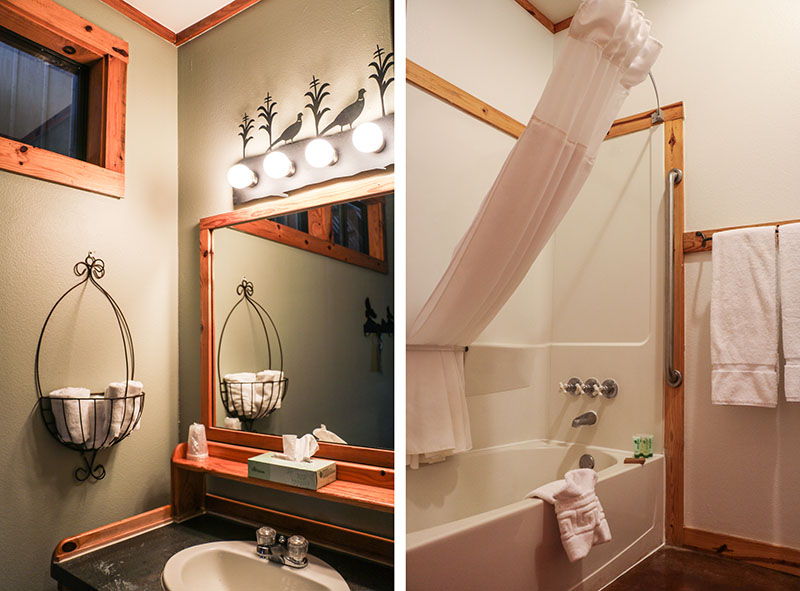
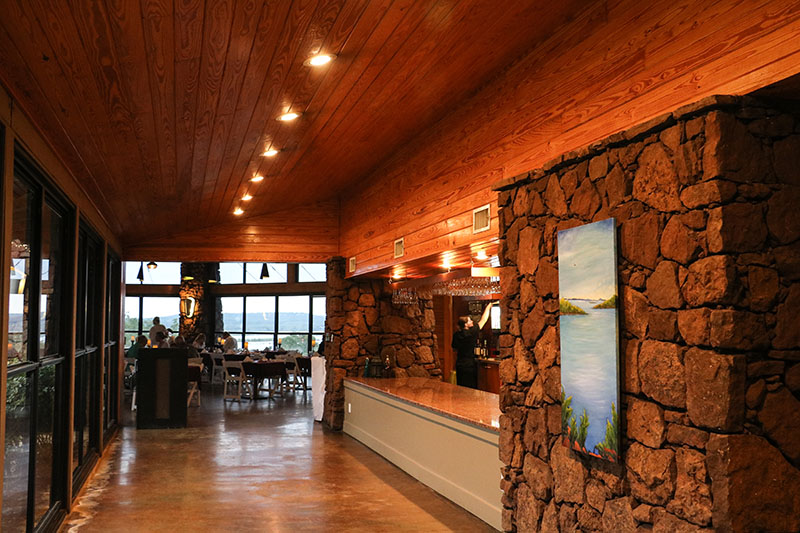
You get a sense of calm driving the winding road around the rolling hills up to Canyon of the Eagles Nature Resort. You know you’re heading somewhere quintessentially Texan and serene, deep in the Hill Country.
Located on Lake Buchanan, the resort has sweeping views of the lake. The guest cottages are spread apart, lending a sense of seclusion under the tall oak trees. A glistening swimming pool invites guests for a dip after activities such as hiking and fishing.
Canyon of the Eagles markets itself as a nature resort, where guests can get away from the hustle and bustle of daily life. Located on 940 acres with 14 miles of groomed hiking trails, there's plenty to do without the distraction of technology. The best part is you don’t have to stay at the resort to take advantage of everything it has to offer; simply pay a daily-use fee at the park gate.
Resort guests may enter their rooms and wonder, “Where’s the TV?”
There are none — that’s the point. No chance of catching high-speed Wi-Fi or exceptional cellphone service either. That’s what feels great about Canyon of the Eagles; it forces you to cut off and disconnect.
The resort is also incredibly dog-friendly. At check-in, dog owners receive homemade dog treats, packaged and labeled for their pooch(es). Every Saturday morning, Roman Gottfried, a holistic K9 trainer, is brought up from Austin for a dog training session followed by a light trail hike. Gottfried is dedicated and knowledgable about our canine friends. He's there to answer any questions and offer individualized advice to dog owners.
At night, the Highland Lakes is known for its excellent stargazing conditions. Canyon of the Eagles is no exception. The stars at night are big and bright at its shining attraction, the on-site Eagle Eye Observatory.
Resident astronomer Jim Sheets leads star viewings each weekend at sundown. Guests can view the moon, planets, galaxies, comets, and more through high-end telescopes. Astronomers from the Austin Astronomical Society (AAS) also travel up to lead public star parties every month. View the AAS Star Party calendar here.
]The Overlook Restaurant, which offers a 360-degree view of the lake, has five-star breakfast, lunch, and dinner menus. Reservations are highly recommended for dinner. Try the Canyon Steak paired with a glass of wine from the local Fall Creek Vineyards.
In addition to its 62 guest rooms, Canyon of the Eagles also offers RV and tent camping. The RV park accommodates 23 sites with water and electric hookups. Tent campers can choose from several well-maintained, yet primitive, camping areas for a rustic experience.
Canyon of the Eagles Nature Resort is located at 16942 RR 2341 in Burnet. For more information, visit www.canyonoftheeagles.com or call (512) 334-2070.
Sip for a cause at Save the World Brewing Co.
Published at 101HighlandLakes.com
Quynh and David Rathcamp started Save the World Brewing Co., a philanthropic brewery in Marble Falls. Staff photo by JoAnna Kopp
February 27, 2017
Save the World Brewing Co. takes its name seriously: The local microbrewery donates 100 percent of its profits to charity. The brewery produces authentic Belgian-style beer you can feel good about — and it tastes good, too.
David and Quynh Rathkamp started the brewery after successful careers as physicians. They combine a love of science with brewing beer and a humanitarian mission.
“Philosophically, we’ve always been concerned about the environment and the planet and people,” Quynh said. “Our regular charities that we support are Food for the Hungry, Meals on Wheels, and Habitat for Humanity — charities that supply basic human needs.”
David had been homebrewing beer for 15 years and took that passion further by attending brewing school, a postgraduate course with lectures in engineering and biology. The Rathkamps’ background in science has helped them. They hold the belief that it’s easy to make beer, and it’s hard to make good beer.
“There’s a lot of science to brewing. Understanding the science behind producing a consistent, quality product makes you much more able to do it well,” Quynh said.
Save the World focuses on brewing Belgian-style beers, which, according to David, are very drinkable and well-balanced.
“With a Belgian beer, you’re going to taste the hop, you’re also going to taste the malt, and you’re going to smell the yeast and everything else in there,” he said. “You get to experience it all in the proper order, so it’s a well-balanced beer that’s crafted with a lot of thought and preparation.”
Everything about the ingredients are thoughtfully chosen. Save the World uses “noble hops,” which are a select group of hops that European brewers have designated for centuries as being superior hops. Its malt is imported from Belgium or Germany. Even the local water is perfect for the process.
“We sent water from this property to Texas A&M to get it analyzed, and the report analysis compared it to the best water used in Belgium — it’s almost identical,” David explained. “People around here complain that the water tastes like minerals, clogs up their shower heads, the calcium from the limestone fogs up their glassware, but it’s perfect for us making Belgian beers.”
All of the beers from Save the World have Latin names, which pay homage to the Rathkamps’ medical background and their love of God.
The beers in their regular lineup are Humilius Filius, Foctum Bonum, and Agnus Dei. Lux Mundi is their renowned “patersbier” (father’s beer). It is a nod to monastery brewhouses, honoring the beer that Belgian monks drink every day.
“Lux Mundi epitomizes what I mean about a well-balanced beer,” David explained. “From the smell to the taste to the way it feels in your mouth, it’s so smooth, you want to take another sip.”
Visit the brewery to check out the tasting room and tour the facility. David leads the tours, breaking down the science of brewing and showing off the state-of-the-art equipment with pride. Tours are open to the public during tasting room hours from 3-6 p.m. Fridays and 1-6 p.m. Saturdays.
Save the World’s beers can be found in retail stores and on tap across Central Texas. It can also be consumed in-house at the brewery. Join Save the World’s “True Beerliever” Club for a free beer, a T-shirt, and an annual birthday brew.
Save the World Brewing Co. is located at 1510 Resource Parkway in Marble Falls. Go to savetheworldbrewing.com or call (830) 637-7654
Camp Brewhaha: zip lines, archery and a lot of beer
By JoAnna Kopp
May 24, 2016
Adult summer camp is a thing — and it’s the best thing ever. On May 6-8, I had the pleasure of attending Camp Brewhaha, a 21-and-older summer camp hosted by the Alamo Drafthouse and Do512.
Camp Brewhaha took place at Camp Champions, located right on Lake LBJ. Photo by JoAnna Kopp
The two-night, three-day, all-inclusive sleepaway camp took place at Camp Champions near Marble Falls, a summer camp that normally hosts camps for kids. From Lake LBJ, Camp Champions looks like the funnest place on Earth: There are personal watercraft, a multi-level rope swing, a giant blob, kayaks, canoes, volleyball, basketball and about every other outdoor activity you can think of.
Campers put their agility and endurance to the test at the Pirate Ropes Course. Photo by JoAnna Kopp
The activities went on all day. From 10 a.m.-1 p.m., campers were invited to try their hand at “Arts & Farts & Crafts,” test their agility and coordination on a pirate-ship-shaped ropes course or choose between swimming in the lake or the swimming pool complete with waterslides and a lazy river. Later in the day, there was a Wiffle ball game, archery, rock-wall climbing, a zip line, a nature hike and so much more.
Glenda McKinney and Eric Bramblett are camp enthusiasts who came to Camp Brewhaha after attending the first one last October. Photo by JoAnna Kopp
I came across Glenda McKinney and Eric Bramblett as they were stepping out of their cabin. The two are older than the average twenty-something camper. They are film enthusiasts who learned about the event from the Alamo Drafthouse.
“Just because we’re in our fifties doesn’t mean we’re too old to have fun,” McKinney asserted. “You haven’t lived until you watch drunk guys try to paddleboard.”
The cabins were co-ed, so the campers were mixed in with complete strangers — unless they planned ahead and got the same cabin as a friend.
“There’s a lot of girl power in my bunk,” said Drew Moncada, another Austinite, who chose his cabin at random. The co-ed cabins didn’t make him shy or stop him from making new friends.
'Let’s just say stuff happens in the woods,' said Drew Moncada after I asked how he enjoyed his first night at Camp Brewhaha. Photo by JoAnna Kopp
Cheeky merit badges were handed out as campers participated in various challenges. Photo by JoAnna Kopp
As I observed each event, I noticed coolers filled to the brim with an assortment of Karbach brews. Campers were welcome to help themselves to as many beers as they liked. Alamo Drafthouse employees in neon pink shirts were acting as moderators at the events, handing out cheeky merit badges for activities. In yellow shirts, though, were actual Camp Champions counselors.
Archery was one of the many challenges at Camp Brewhaha. Photo by JoAnna Kopp
I spoke with Annie Verzwyvelt, a high school senior approaching graduation. She was standing on a bench at the archery arena, shouting orders and keeping everybody in line — people were mixing alcohol and archery, after all. I asked how she felt about supervising drunk adults compared to the Girl Scout camp that had been held the previous weekend.
'This is definitely my favorite job I’ve ever had,' said 18-year-old Annie Verzwyvelt, a counselor at Camp Champions. Photo by JoAnna Kopp
“I love working with kids, seeing them smile after accomplishing something. There are more safety issues with the kids. You have to guide them around and make sure they’re following the rules. It’s different with adults,” she said, “At the rock wall, we call ‘fail’ the F-word — I’ve been hearing a different F-word this weekend.”
Frankie Carusa, a bartender in Austin, and Cameron Mangiafico, a nurse in Cedar Park, kick back and watch people soar through the air at Camp Brewhaha. Photo by JoAnna Kopp
I talked to Frankie Carusa and Cameron Mangiafico, campers who were lounging in the grass and watching the ‘eagle' activity in which a group of campers ran a tether that pulled another camper up 20 feet in the air. When the tether was released, the camper would start swinging like a pendulum.
Campers were able to fly like an eagle in the 'Screaming Eagle' feature at Camp Brewhaha. Photo by JoAnna Kopp
Carusa never went to summer camp when he was younger, which is why he came out to Camp Brewhaha. Mangiafico came out because the experience was nostalgic for her; it was everything she had done as a kid.
“I just love that as adults we can do it as we should have done. The camp counselors aren’t corralling you around and telling you what to do. You do what you want to do,” she said.
'That was the most fun I’ve ever had. I’d recommend it to anybody,' said Daniel Derity (right) after he and Cori Robarge were pulled on a tube behind the jet ski. ‘The driver said we survived his worst.' Photo by JoAnna Kopp
As the sun set on Saturday, I heard the sound of bagpipes, which felt like the cherry on top of a real summer camp experience. I tracked down the guy on the pipes, Andre De la Reza. To my surprise, he was a regular camper.
Andre de la Reza and Lyzz Donelson, firefighters from Austin, played their bagpipes at sundown on Saturday. Photo by JoAnna Kopp
“When I was packing up for camp, I couldn’t not bring my bagpipes,” he explained. "I am president of the Emergency Service Pipes and Drums Association. We are a nonprofit made up of police, firefighters and paramedics. We play the bagpipes for heroes that died in the line of duty, all across Texas.”
Holiday Mountain started a dance party in the mess hall at Camp Brewhaha. Photo by JoAnna Kopp
At night, things didn’t wind down. Austin electronic party band Holiday Mountain performed a show in the mess hall, starting a dance party complete with a disco ball and strobe lights.
“I never went to summer camp as a kid,” vocalist Laura Patiño lamented to the crowd, “so performing in this cafeteria and imagining the meals I could have had … that’s something else.”
The Alamo Drafthouse Rolling Roadshow prepared several camp themed movies to show at Camp Brewhaha. Photo by JoAnna Kopp
Outside in the sports field, the Alamo Drafthouse Rolling Roadshow set up film screenings of camp-themed movies throughout the night: “Meatballs,” “Addams Family Values,” “Wet Hot American Summer,” “Sleepaway Camp,” “Moonrise Kingdom” and more. The huge blow-up screen made it feel like I was in a real theater. I was blown away by how crystal-clear the sound quality was.
The tickets for Camp Brewhaha are $325 per person. The price seems steep, but consider that the open bar, breakfast, lunch, dinner and all activities are included in the price of the ticket.
Camp Brewhaha will be returning in the fall from Oct. 28-30 for “Halloweekend.” Get your tickets for the weekend at Camp-Brewhaha.com.
